Infrared Gas Detection and Concentration Inversion Based on Dual-Temperature Background Points
Abstract
1. Introduction
2. Theory and Method
2.1. The Radiance Transfer Model
2.2. Simplified Layer Model
2.3. Infrared Gas Detection and Concentration Inversion Method Based on Dual-Temperature Background Points
3. Discussion and Details
3.1. Limitation of Critical Temperature in Traditional Method
3.2. Selection of Reference and Measurement Band
3.3. Calculation of Target Gas Concentration Using MODTRAN
4. Experiments and Analysis
4.1. Verification Experiments and Result Analysis of CO2 Imaging Detection
- Activate the cooled mid-wave infrared detector and wait until the operating temperature is reached, with the blackbody temperature set at 50 °C.
- The detector acquires three images as background images after the blackbody temperature is stabilized.
- The detector collects images when a human exhales carbon dioxide in front of the blackbody background.
- Adjust the filter wheel and choose filters with bands of 4~4.5 μm and 4.5~5 μm in turn and repeat steps 2 to 3.
4.2. Experiment and Result Analysis of Gas Detection Method Based on Dual-Temperature Background Points
- Activate the cooled mid-wave infrared detector and allow it to stabilize at the operating temperature with the blackbody temperature set at 40 °C and 50 °C in turn.
- The detector acquires the background images of the reference and measurement bands without the target gas and for each condition collects three images.
- Release the carbon dioxide standard gas and ensure that the target gas region covered contains the background. The detector collects the corresponding on-gas images of the reference and measurement bands.
5. Conclusions
Author Contributions
Funding
Institutional Review Board Statement
Informed Consent Statement
Data Availability Statement
Conflicts of Interest
References
- Meribout, M. Gas Leak-Detection and Measurement Systems: Prospects and Future Trends. IEEE Trans. Instrum. Meas. 2021, 70, 4505813. [Google Scholar] [CrossRef]
- Lu, H.; Iseley, T.; Behbahani, S.; Fu, L. Leakage Detection Techniques for Oil and Gas Pipelines: State-of-the-Art. Tunn. Undergr. Space Technol. 2020, 98, 103249. [Google Scholar] [CrossRef]
- Meribout, M.; Khezzar, L.; Azzi, A.; Ghendour, N. Leak Detection Systems in Oil and Gas Fields: Present Trends and Future Prospects. Flow Meas. Instrum. 2020, 75, 101772. [Google Scholar] [CrossRef]
- Xiong, K.; Jiang, J.; Pan, Y.; Yang, Y.; Chen, X.; Yu, Z. Deep Learning Approach for Detection of Underground Natural Gas Micro-Leakage Using Infrared Thermal Images. Sensors 2022, 22, 5322. [Google Scholar] [CrossRef] [PubMed]
- Zhang, Z.; Zhang, F.; Xu, B.; Xie, H.; Fu, B.; Lu, X.; Zhang, N.; Yu, S.; Yao, J.; Cheng, Y.; et al. High-Sensitivity Gas Detection with Air-Lasing-Assisted Coherent Raman Spectroscopy. Ultrafast Sci. 2022, 2022, 9761458. [Google Scholar] [CrossRef]
- Liu, X.; Qiao, S.; Han, G.; Liang, J.; Ma, Y. Highly Sensitive HF Detection Based on Absorption Enhanced Light-Induced Thermoelastic Spectroscopy with a Quartz Tuning Fork of Receive and Shallow Neural Network Fitting. Photoacoustics 2022, 28, 100422. [Google Scholar] [CrossRef] [PubMed]
- Zhao, Q.; Nie, X.; Luo, D.; Wang, J.; Li, Q.; Chen, W. An Effective Method for Gas-Leak Area Detection and Gas Identification with Mid-Infrared Image. Photonics 2022, 9, 992. [Google Scholar] [CrossRef]
- Murvay, P.-S.; Silea, I. A Survey on Gas Leak Detection and Localization Techniques. J. Loss Prev. Process Ind. 2012, 25, 966–973. [Google Scholar] [CrossRef]
- Mammen, C.H.; Benson, R.G. Thermography Camera Configured for Gas Leak Detection. Patent 7649174, 19 January 2010. Available online: https://www.freepatentsonline.com/7649174.html (accessed on 2 March 2023).
- Naranjo, E.; Baliga, S.; Bernascolle, P. IR Gas Imaging in an Industrial Setting. In Thermosense XXXII; SPIE: Orlando, FL, USA, 2010; Volume 7661, pp. 160–167. [Google Scholar] [CrossRef]
- Hashmonay, R.; Yanai, O. Methods for Classification of a Gas Compound in a Gas Leak. Patent 20210102840, 8 April 2021. Available online: https://www.freepatentsonline.com/y2021/0102840.html (accessed on 2 March 2023).
- Shiozawa, D.; Uchida, M.; Ogawa, Y.; Sakagami, T.; Kubo, S. Four-Dimensional Reconstruction of Leaked Gas Cloud Based on Computed Tomography Processing of Multiple Optical Paths Infrared Measurement. Eng. Proc. 2021, 8, 33. [Google Scholar] [CrossRef]
- Rangel, J.; Schmoll, R.; Kroll, A. On Scene Flow Computation of Gas Structures with Optical Gas Imaging Cameras. In Proceedings of the 2020 IEEE Winter Conference on Applications of Computer Vision (WACV), Snowmass Village, CO, USA, 1–5 March 2020; pp. 174–182. [Google Scholar] [CrossRef]
- Abdel-Moati, H.; Morris, J.; Zeng, Y.; Kangas, P.; McGregor, D. New Optical Gas Imaging Technology for Quantifying Fugitive Emission Rates. In Proceedings of the IPTC International Petroleum Technology Conference, Doha, Qatar, 6–8 December 2015. [Google Scholar] [CrossRef]
- Zeng, Y.; Morris, J.; Sanders, A.; Mutyala, S.; Zeng, C. Methods to Determine Response Factors for Infrared Gas Imagers Used as Quantitative Measurement Devices. J. Air Waste Manag. Assoc. 2017, 67, 1180–1191. [Google Scholar] [CrossRef] [PubMed]
- Dierks, S.; Kroll, A. Quantification of Methane Gas Leakages Using Remote Sensing and Sensor Data Fusion. In Proceedings of the 2017 IEEE Sensors Applications Symposium (SAS), Glassboro, NJ, USA, 13–15 March 2017; pp. 1–6. [Google Scholar] [CrossRef]
- Kang, R.; Liatsis, P.; Kyritsis, D.C. Emission Quantification via Passive Infrared Optical Gas Imaging: A Review. Energies 2022, 15, 3304. [Google Scholar] [CrossRef]
- Sandsten, J.; Edner, H.; Svanberg, S. Gas Imaging by Infrared Gas-Correlation Spectrometry. Opt. Lett. 1996, 21, 1945–1947. [Google Scholar] [CrossRef] [PubMed]
- Sandsten, J.; Weibring, P.; Edner, H.; Svanberg, S. Real-Time Gas-Correlation Imaging Employing Thermal Background Radiation. Opt. Express 2000, 6, 92–103. [Google Scholar] [CrossRef] [PubMed]
- Wu, K.; Feng, Y.; Yu, G.; Liu, L.; Li, J.; Xiong, Y.; Li, F. Development of an Imaging Gas Correlation Spectrometry Based Mid-Infrared Camera for Two-Dimensional Mapping of CO in Vehicle Exhausts. Opt. Express 2018, 26, 8239–8251. [Google Scholar] [CrossRef] [PubMed]
- Flanigan, D.F. Limits of Passive Remote Detection of Hazardous Vapors by Computer Simulation. In Electro-Optical Technology for Remote Chemical Detection and Identification; Fallahi, M., Howden, E.A., Eds.; SPIE: Orlando, FL, USA, 1996; Volume 2763, pp. 117–127. [Google Scholar] [CrossRef]
- Gordon, I.E.; Rothman, L.S.; Hargreaves, R.J.; Hashemi, R.; Karlovets, E.V.; Skinner, F.M.; Conway, E.K.; Hill, C.; Kochanov, R.V.; Tan, Y.; et al. The HITRAN2020 Molecular Spectroscopic Database. J. Quant. Spectrosc. Radiat. Transf. 2022, 277, 107949. [Google Scholar] [CrossRef]
- Greenhouse Gas Concentrations—Graphing Tool | NOAA Climate.gov. Available online: http://www.climate.gov/maps-data/dataset/greenhouse-gas-concentrations-graphing-tool (accessed on 26 March 2023).


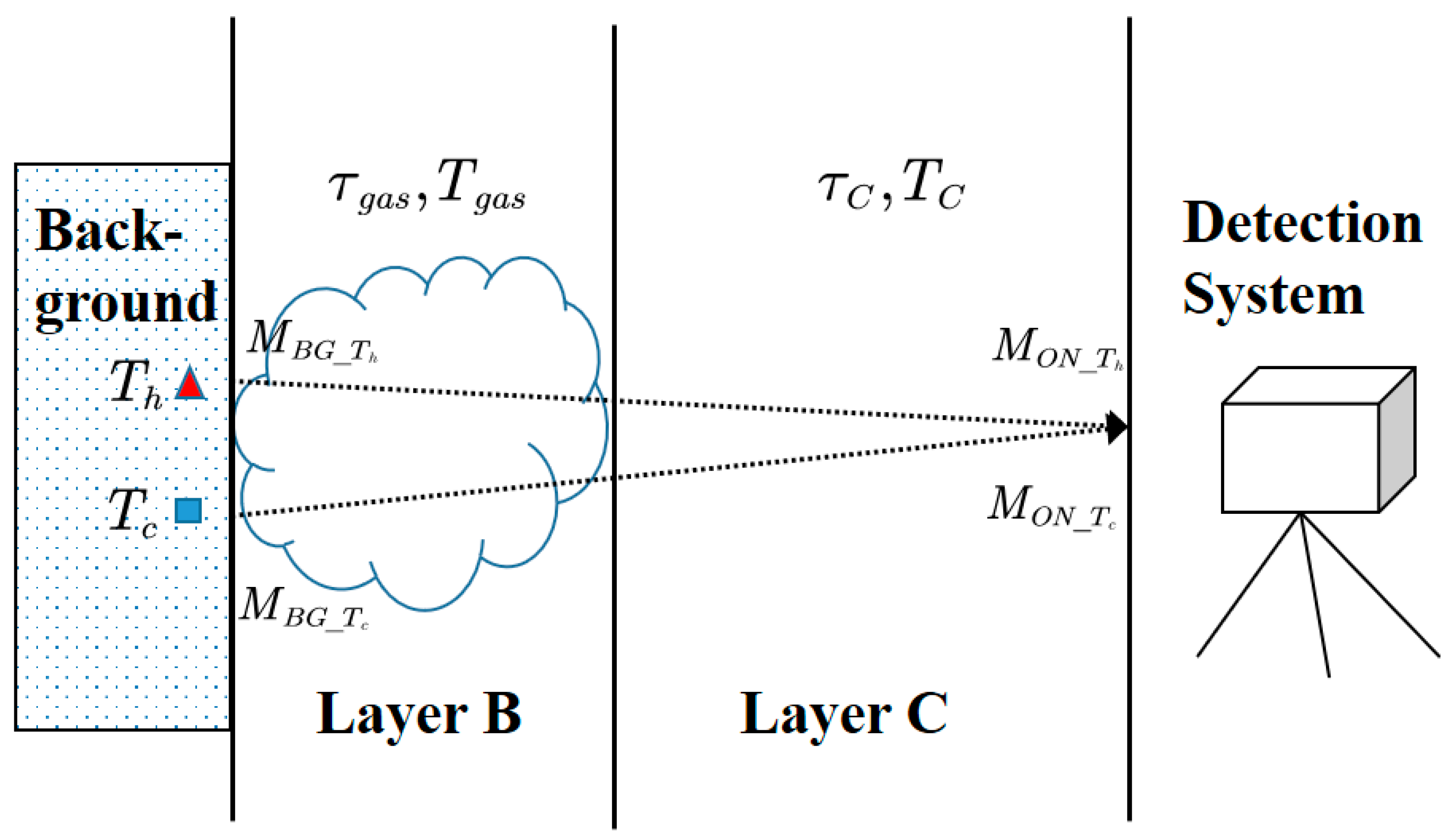
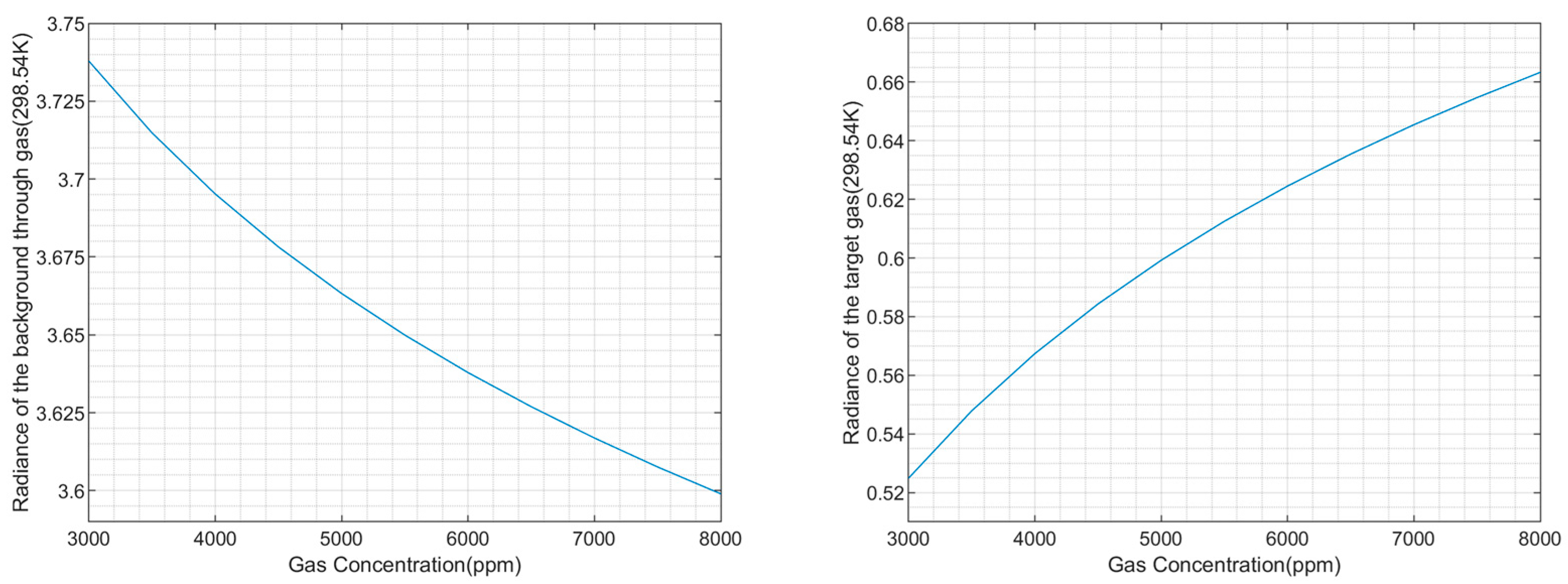




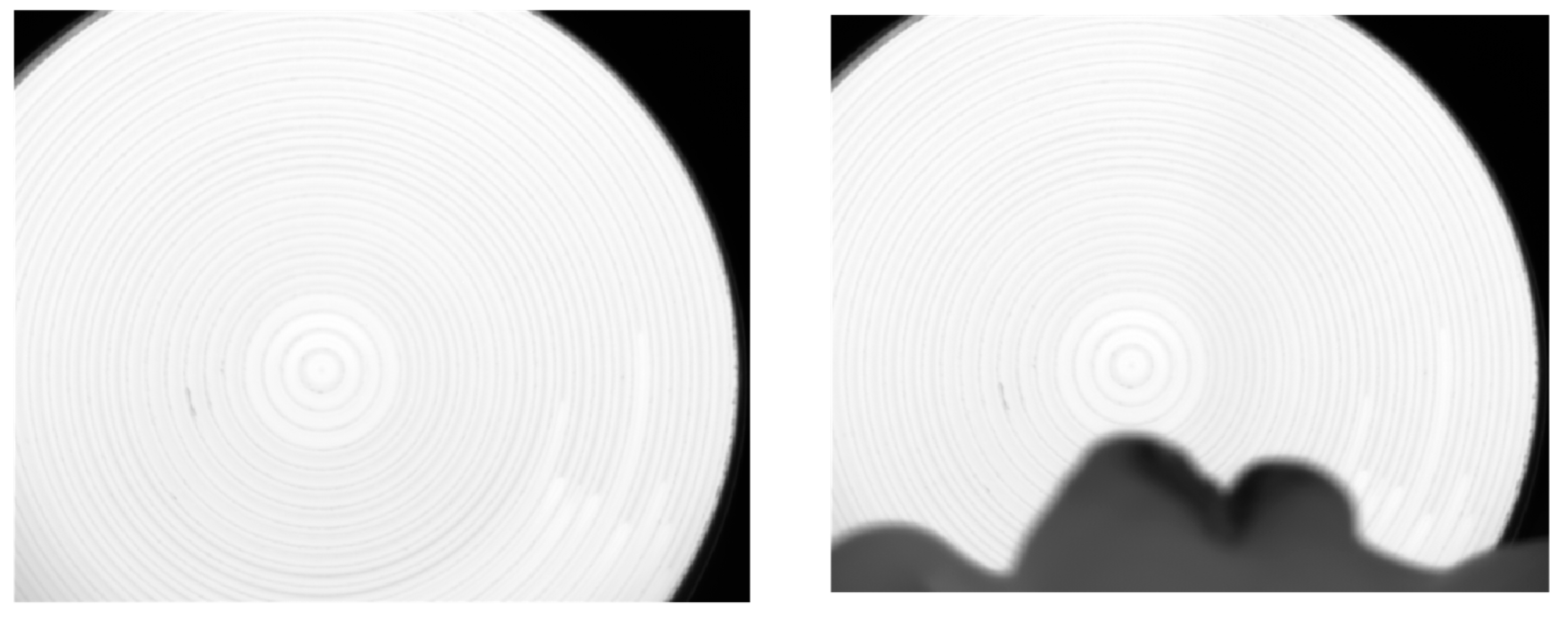

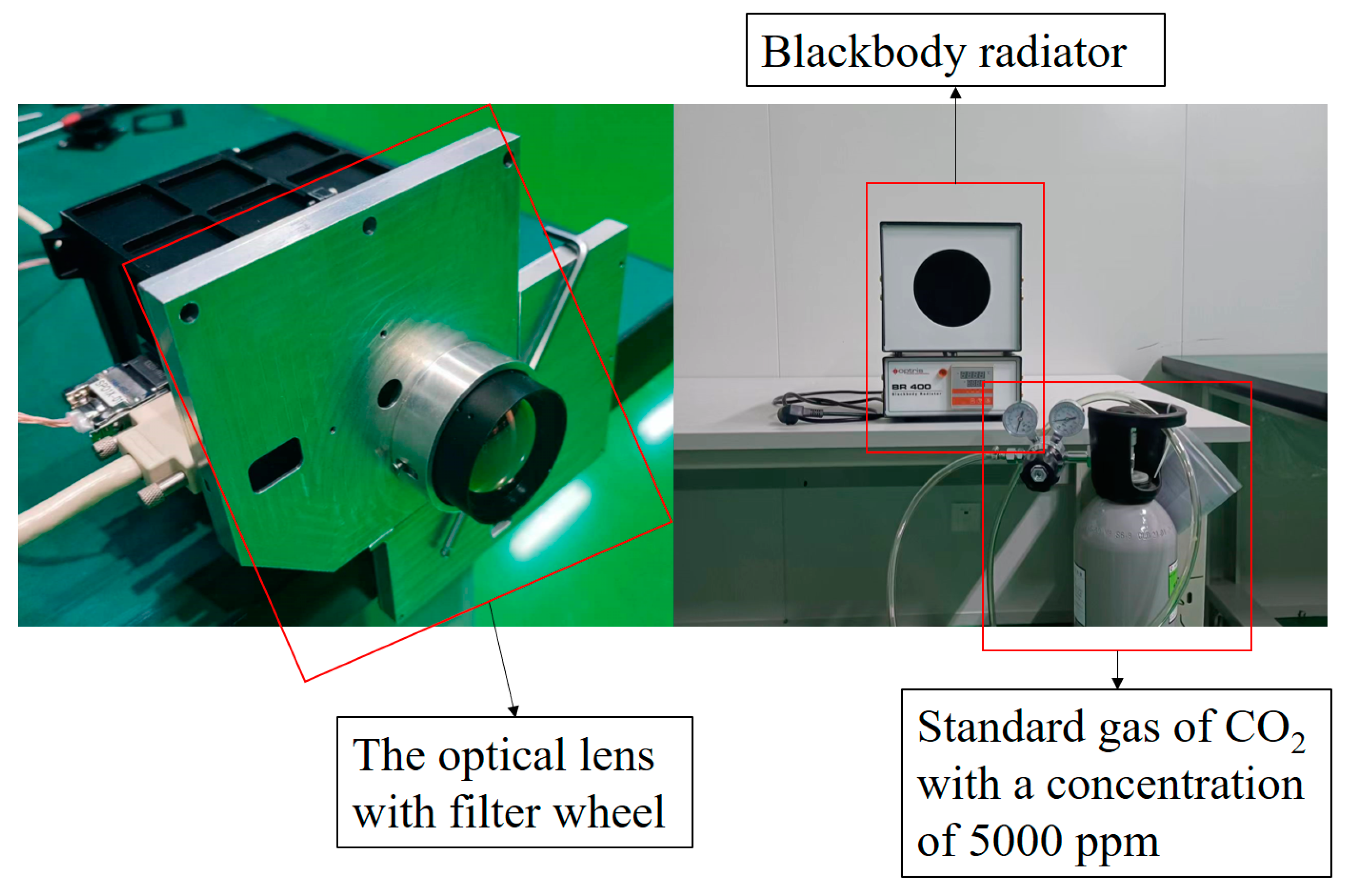
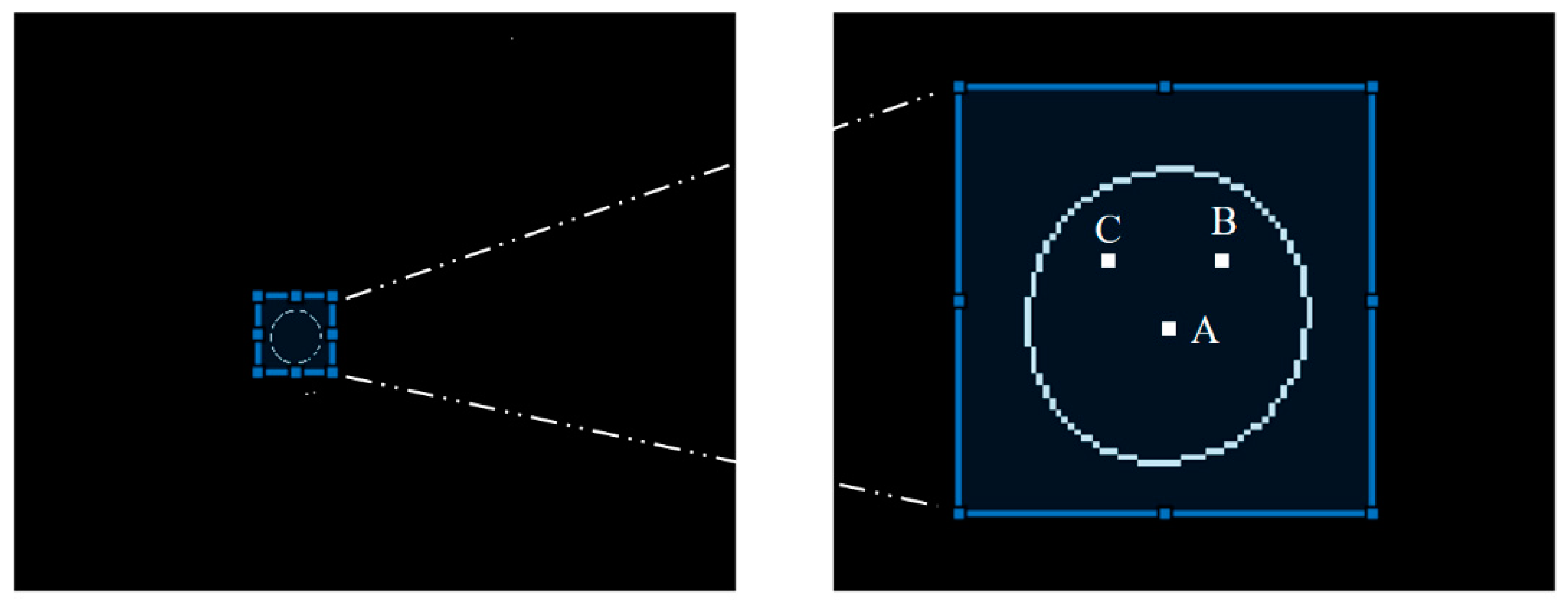
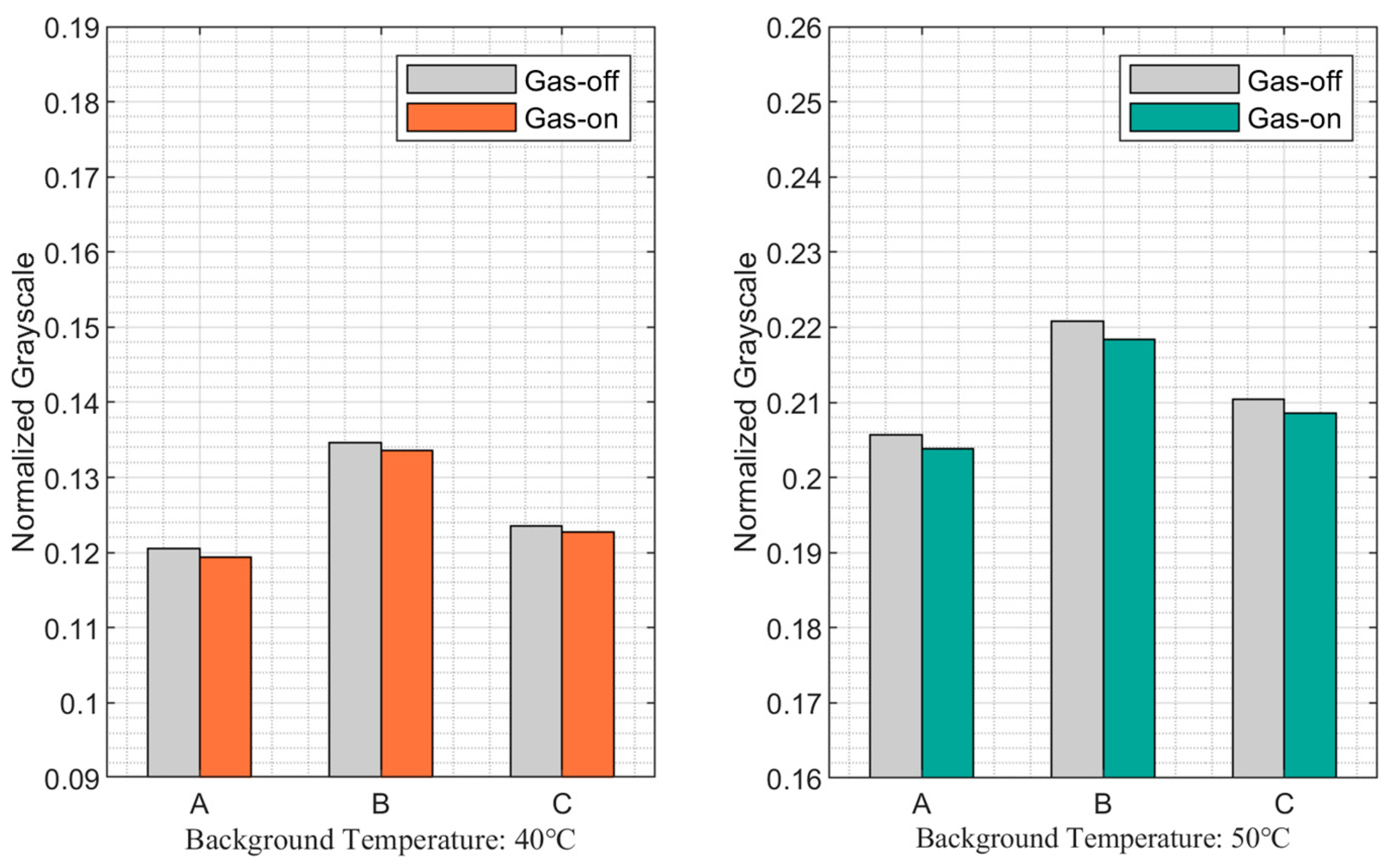

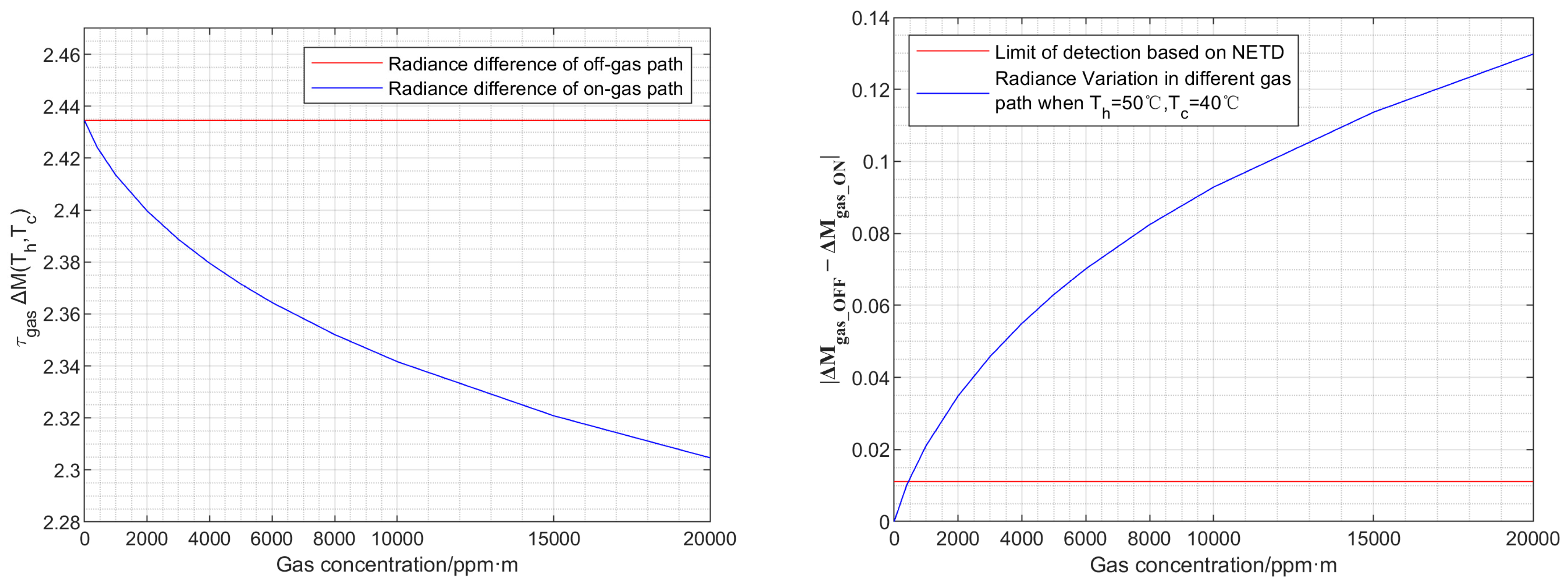
| Frechet-Distance (Curve Similarity) | Tc = 10~100 °C, Th = Tc + ΔT, ΔT = 10 °C | Tc = 10 °C, Th = Tc + ΔT, ΔT = 10~50 °C |
|---|---|---|
| Data of 4.5~5 μm | 0.52816 | 0.20562 |
| Data of 3.5~3.9 μm | 0.90065 | 0.32329 |
| Data of 4~4.2 μm | 0.21579 | 0.08408 |
| Relative Change in the Presence/Absence of CO2 (%) | ||||
|---|---|---|---|---|
| A | B | C | Average | |
| Ref_40 °C | 0.91395 | 0.72444 | 0.64286 | 0.76042 |
| Ref_50 °C | 0.90547 | 1.05416 | 0.89776 | 0.95246 |
| Mea_40 °C | 5.26513 | 5.38866 | 5.33793 | 5.33057 |
| Mea_50 °C | 4.19719 | 4.26510 | 4.25491 | 4.23907 |
| Data Process Results | ||||
| A | B | C | Average | |
| 0.08515 | 0.08614 | 0.08687 | 0.08605 | |
| 0.08439 | 0.08479 | 0.08578 | 0.08498 | |
| 0.33214 | 0.34089 | 0.34218 | 0.33840 | |
| 0.32396 | 0.33253 | 0.33357 | 0.33002 | |
| Estimated target gas concentration (ppm m) | 4611 | 4588 | 4778 | 4659 |
| Theoretical concentration: 5000 ppm | ||||
| Relative Deviation (%) | 7.78 | 8.24 | 4.44 | 6.82 |
| Assume the NETD of Infrared System: 40 mK@25 °C | |
|---|---|
| Limit of Detection | |
| 0.00122 | |
| Value of Measurement Band | Setting: Th = 30 °C Tc = 20 °C | Setting: Th = 50 °C Tc = 40 °C | ||
|---|---|---|---|---|
| 0.29790 | 0.57789 | |||
| Concentration (ppm·m) | Difference between On-Gas/Off-Gas Path | Difference between On-Gas/Off-Gas Path | ||
| 2 | 0.29789 | 6.99 × 10−6 | 0.57788 | 1.38 × 10−5 |
| 250 | 0.29699 | 0.00091 | 0.57610 | 0.00180 |
| 500 | 0.29616 | 0.00174 | 0.57416 | 0.00373 |
| 900 | 0.29497 | 0.00293 | 0.57212 | 0.00577 |
| 2500 | 0.29118 | 0.00672 | 0.56466 | 0.01323 |
| 3000 | 0.29020 | 0.0077 | 0.56273 | 0.01517 |
| 5000 | 0.28681 | 0.01109 | 0.55607 | 0.02182 |
| 7500 | 0.28333 | 0.01457 | 0.54927 | 0.02863 |
| 10,000 | 0.28035 | 0.01755 | 0.54344 | 0.03445 |
| 12,500 | 0.27770 | 0.02020 | 0.53826 | 0.03963 |
Disclaimer/Publisher’s Note: The statements, opinions and data contained in all publications are solely those of the individual author(s) and contributor(s) and not of MDPI and/or the editor(s). MDPI and/or the editor(s) disclaim responsibility for any injury to people or property resulting from any ideas, methods, instructions or products referred to in the content. |
© 2023 by the authors. Licensee MDPI, Basel, Switzerland. This article is an open access article distributed under the terms and conditions of the Creative Commons Attribution (CC BY) license (https://creativecommons.org/licenses/by/4.0/).
Share and Cite
Wu, S.; Zhong, X.; Qu, Z.; Wang, Y.; Li, L.; Zeng, C. Infrared Gas Detection and Concentration Inversion Based on Dual-Temperature Background Points. Photonics 2023, 10, 490. https://doi.org/10.3390/photonics10050490
Wu S, Zhong X, Qu Z, Wang Y, Li L, Zeng C. Infrared Gas Detection and Concentration Inversion Based on Dual-Temperature Background Points. Photonics. 2023; 10(5):490. https://doi.org/10.3390/photonics10050490
Chicago/Turabian StyleWu, Sipeng, Xing Zhong, Zheng Qu, Yuanhang Wang, Lei Li, and Chaoli Zeng. 2023. "Infrared Gas Detection and Concentration Inversion Based on Dual-Temperature Background Points" Photonics 10, no. 5: 490. https://doi.org/10.3390/photonics10050490
APA StyleWu, S., Zhong, X., Qu, Z., Wang, Y., Li, L., & Zeng, C. (2023). Infrared Gas Detection and Concentration Inversion Based on Dual-Temperature Background Points. Photonics, 10(5), 490. https://doi.org/10.3390/photonics10050490






